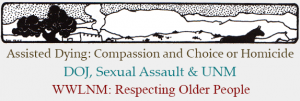Wellness RSS feed for this section
Where the Top Soil is Thin
The top soil on my land in the Manzanita Mountains is thin. It is so thin that when I dig up the roots of a dead tree, they are more rock than fiber. The tentacles that feed growth are desperately wrapped around stones in their striving to find nourishment. The top soil is so shallow that when the high winds of spring whistle through the forest, roots pull from the ground and big trees, some of them a century or two old, topple to the earth.
When I moved to the East Mountains many a moon ago, it took me a few months to understand how thin the top soil was. But it’s taken all these years for me to discover how thin my own top soil is...
Continue reading...Insight New Mexico: Joan Gibson
30. April 2015

Joan Gibson talks about the importance of advanced care planning at various stages of our lives and her initiative to involve a Health Care Companion to that process.
Continue reading...What’s Death Got to Do with It?
16. April 2015
April 16, 2015 is National Health Care Decisions Day. It is a day when we are invited to take stock of our health status, ponder what matters to us medically, and discuss this with those who need to know.
On its website this grass roots initiative describes the problem it aims to solve:
“Despite recent gains in public awareness of the need for advance care planning, studies indicate that most Americans have not exercised their right to make decisions about their healthcare in the event that they cannot speak for themselves.”...
Continue reading...Insight New Mexico - Maureen Sanders
11. March 2015

V.B. Price talks with civil rights attorney Maureen Sanders about the history of reproductive rights in New Mexico and her role in one of its biggest legal challenges.
Continue reading...To Sibundoy and Back
03. March 2015

Ayahuasca, or yagé, is a substance used as a shamanistic vehicle in parts of the Amazon and is known for its divinatory and healing powers. A New Mexican describes his journey through an Ayahuasca ceremony.
Continue reading...Insight New Mexico - Dr. Lance Chilton
26. February 2015

V.B. Price talks with pediatrician and immunization expert Dr. Lance Chilton about the ongoing controversy over vaccines, their safety and their effectiveness.
Continue reading...Susana Whiffed on Behavioral Health
04. February 2015
Two years after blowing New Mexico’s community behavioral health system to smithereens and bringing in companies from Arizona to replace it, spending $27 million in the process, the topic of behavioral health drew nary a mention from our Governor in her State of the State speech.
Nor did any of the press releases that accompanied her proposed budget for next year mention the topic. It is not the subject of any legislative proposals sent down from the Fourth Floor. She has no position on Albuquerque and Bernalillo County’s efforts to address the needs of the mentally ill and addicted populations, which include requests for additional taxes here and for increased State appropriations for services...
Continue reading...Provincial Matters, 1-12-2015
12. January 2015

V.B. Price's weekly collection of observations and appreciations.
Continue reading...Artists in the Desert
17. December 2014
The idea of art as therapy was established in the late 18th century when it was used as “moral treatment” for psychiatric patients. The term “art therapy” came from a British war artist named Adrian Hill who used to go out on patrols with his sketching kit in World War I and who later recognized the therapeutic value of art while he was recovering from tuberculosis. This concept grew with the establishment of the British Association of Art Therapists in 1964 and the American Art Therapy Association in 1969, as well as similar associations in about a dozen other countries and it is now a well-recognized form of therapy. For example, the Southwestern College here in Santa Fe offers an MA in Art Therapy, focusing on “the healing process of making art.”
But what if you have one hundred mental patients and no therapist or even an instructor and can only infrequently afford the necessary paint and art supplies?..
Continue reading...Reflections on Mary Jane
10. December 2014
Okay, here it is: I started smoking pot in 1967, and I’ve continued to enjoy the Herb, on and off, since then. I’ve lived through it all. Mexican weed, which was the only kind you could buy, was ten bucks a can. A “can” was literally a 1½-ounce Prince Albert shiny red oval tobacco can, with a metal top, a lid, filled with their leafy “crimp cut” rolling or pipe tobacco.
The dealer would stuff one of these empty cans—a classic example of early recycling— with marijuana from Mexico, stems and twigs and buds and seeds into this can—a sawbuck. Two fins...
Continue reading...

01. May 2015
4 Comment